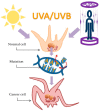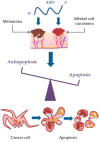Advances in the Understanding of Skin Cancer: Ultraviolet Radiation, Mutations, and Antisense Oligonucleotides as Anticancer Drugs
- PMID: 30999681
- PMCID: PMC6514765
- DOI: 10.3390/molecules24081516
Advances in the Understanding of Skin Cancer: Ultraviolet Radiation, Mutations, and Antisense Oligonucleotides as Anticancer Drugs
Abstract
Skin cancer has always been and remains the leader among all tumors in terms of occurrence. One of the main factors responsible for skin cancer, natural and artificial UV radiation, causes the mutations that transform healthy cells into cancer cells. These mutations inactivate apoptosis, an event required to avoid the malignant transformation of healthy cells. Among these deadliest of cancers, melanoma and its 'younger sister', Merkel cell carcinoma, are the most lethal. The heavy toll of skin cancers stems from their rapid progression and the fact that they metastasize easily. Added to this is the difficulty in determining reliable margins when excising tumors and the lack of effective chemotherapy. Possibly the biggest problem posed by skin cancer is reliably detecting the extent to which cancer cells have spread throughout the body. The initial tumor is visible and can be removed, whereas metastases are invisible to the naked eye and much harder to eliminate. In our opinion, antisense oligonucleotides, which can be used in the form of targeted ointments, provide real hope as a treatment that will eliminate cancer cells near the tumor focus both before and after surgery.
Keywords: Merkel cell carcinoma; antisense oligonucleotides; basal cell carcinoma; dermatofibrosarcoma protuberans; melanoma; mutations; skin; squamous cell carcinoma; ultraviolet radiation.
Conflict of interest statement
The authors have no conflicts of interest.
Figures







References
-
- Leiter U., Garbe C. Epidemiology of melanoma and non-melanoma skin cancer—The role of sunlight. Adv. Exp. Med. Biol. 2008;624:89–103. - PubMed
-
- World Health Organization Skin Cancers /online/ [(accessed on 3 February 2019)]; Available online: http://www.who.int/uv/faq/skincancer/en/print.html.
Publication types
MeSH terms
Substances
LinkOut - more resources
Full Text Sources
Other Literature Sources
Medical

